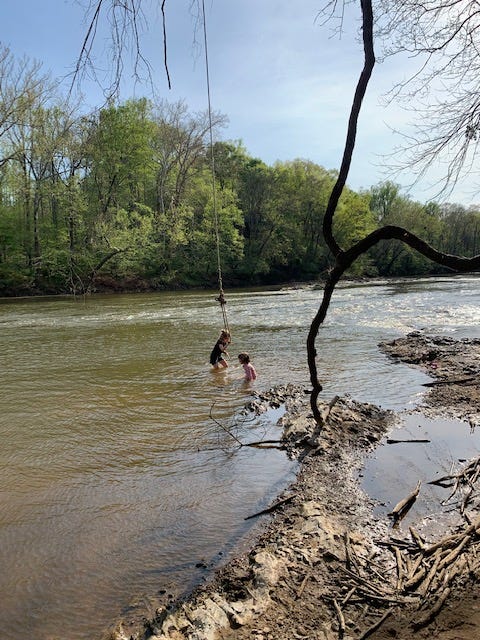I took this video a couple of weeks ago, just before a big storm predicted to cause flooding. Harriet was home for the day and we were worried about frogs—specifically, frog eggs we’d seen days earlier. If the storm washed them away, those eggs probably wouldn’t have a chance to grow into frogs and continue their important life cycle.
So Harriet scooped them up into a jar, and for now they live on top of Bea’s dresser. They soon hatched into tadpoles, and they’re now eating shredded romaine lettuce, basil leaves, and egg yolk. When they develop legs—or maybe before—we’ll return them to the stream.
This time of year, it doesn’t hurt to check out any puddles you see, especially during dry stretches. Today, Bea and I plan to hike down to a puddle where we’ve been watching some tadpoles. We’re pretty sure the puddle will dry up before it rains again, so we’re going to transfer those tadpoles to a healthy stream, and maybe the ones on Bea’s dresser too, since we’re headed out of town next week.
We don’t plan to post on Sunday, but we will post next week—Tuesday, Wednesday, Thursday, and Friday, as long as our wifi holds! We’ll have a lot to write about, since on Tuesday we’ll be boarding a bus headed for civil rights sites in Atlanta, Montgomery, Birmingham, and Selma. We are so excited, and can’t wait to tell you about our trip.
In the meantime, it’s tadpole season, and we thought we’d re-post this excellent advice written by Beatrice last year:
How to Get Your Frogs Out of Trouble
by Beatrice Allen
Have you ever found tadpoles or frog eggs in a puddle that was just about to dry up? That happened to us! Here is what to do:
First quickly gather supplies, like a jar and a net, and GO TO THE PUDDLE.
Then try to get as many egg sacs as you can. Be careful not to squish them. Scoop them into a jar with clear, clean water*. Take some of their puddle water with them.
When you get home, fill a pan or jar with water that is room temperature and carefully pour the tadpoles in. Don’t put a lid on your jar!
Watch closely to see when they hatch. Then give them a little boiled egg yolk to eat. Also give them lettuce, and collect algae if you can. Give the algae to the tadpoles. If it’s above freezing, leave them outside in the sun. Make sure they get enough shade so the water doesn’t get too hot, and watch them every day. If they get legs, that is great! If it’s cold but not freezing, they might slow down, but don’t worry, they’re not dead.
Once they get front legs, it’s time to put them in a tank or jar with shallow water they can crawl out of. We used two big jars, and added rocks and moss. We had to put screen on top so they can’t climb out.
Once they are little frogs with small or no tails, you should let them go so they can eat bugs and do frog stuff! Be sure to let them go near calm water, like a stream or a pond.
*IMPORTANT: We have well water, so it’s not treated with chemicals. Treated city water or town water isn’t good for tadpoles. Give them bottled water, or scoop some water from an unpolluted pond or stream.
Also, if you’re worried about your outdoor jar attracting mosquitoes or your froglets getting out, cut a piece of screen and put that over the top with a lid ring. Just remember that at some point, they’re gonna need to eat bugs.
Hey—don’t frog and toad tadpoles look the same? How can I tell the difference?
Actually, they look different! Toads lay their eggs in long strings, like a necklace, and toad tadpoles are black and sleek. Frogs lay eggs in clusters, and frog tadpoles are mottled and golden.
P.S. Just a reminder that wild animals belong in nature, and frogs (and turtles) should only be moved from their homes if they are in danger.






Share this post